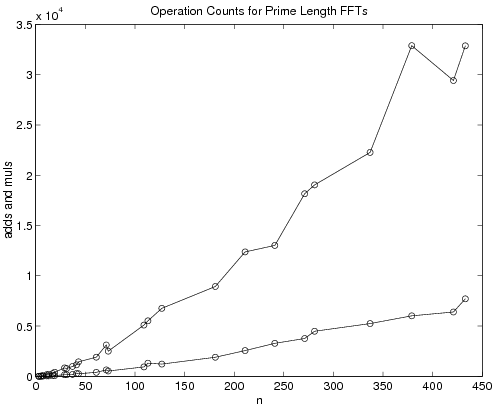Programs for Prime Length FFTs
Using the circular convolution algorithms
described above, we can easily design algorithms
for prime length FFTs.
The only modifications that needs to be made involve
the permutation of Rader 5 and
the correct calculation of the DC term (y(0)).
These modifications are easily made to the above described
approach.
It simply requires a few extra commands in the
programs.
Note that the multiplicative constants are
computed directly, since we have programs
for all the relevant operations.
In the version we have currently implemented
and verified for correctness,
we precompute the multiplicative constants, the input permutation and the
output permutation.
From Equation 8 from A Bilinear Form for the DFT, the multiplicative constants are given
by  ,
the input permutation is given by
1⊕PQr, and the output permutation is given by
1⊕QstJPt.
The multiplicative constants, the input and output permutation are
each stored as vectors.
These vectors are then passed to the prime length FFT program,
which consists of the appropriate function calls,
see the appendix.
In previous prime length FFT modules, the input and output
permutations can be completely absorbed in to the computational
instructions. This is possible because they are written as straight
line code.
It is simple to modify the code generating program we have implemented so that
it produces straight line code and absorbs the permutations
in to the computational program instructions.
,
the input permutation is given by
1⊕PQr, and the output permutation is given by
1⊕QstJPt.
The multiplicative constants, the input and output permutation are
each stored as vectors.
These vectors are then passed to the prime length FFT program,
which consists of the appropriate function calls,
see the appendix.
In previous prime length FFT modules, the input and output
permutations can be completely absorbed in to the computational
instructions. This is possible because they are written as straight
line code.
It is simple to modify the code generating program we have implemented so that
it produces straight line code and absorbs the permutations
in to the computational program instructions.
In an in-place in-order prime factor algorithm for the DFT 1, 6,
the necessary permuted forms of the DFT can be obtained
by modifying the multiplicative constants.
This can be easily done by permuting the roots of unity, w,
in the expression for the multiplicative constants 1, 3,
nothing else in the structure of the algorithm needs to be changed.
By changing the multiplicative constants, it is not possible,
however, to omit the permutation required for Rader's conversion
of the prime length DFT in to circular convolution.
Table 7.1 lists the arithmetic operations
incurred by the FFT programs we have generated and
verified for correctness.
Note that the number of additions and multiplications
incurred by the programs we have generated
are the same as previously existing programs for prime lengths
up to and including 13.
For p=17 a program with 70 multiplications and 314 additions
has been written,
and for p=19 a program with 76 multiplications and 372 additions
has been written 2.
Thus for the length p=17, the program we have generated
requires fewer total arithmetic operations,
while for p=19, ours uses more.
There are several table of operation counts in 4, each
table corresponding to a different variation of the algorithms
used in that paper.
For each variation, the algorithms we have described use fewer
additions and fewer multiplications.
The focus of 4, however, is the implementation
of prime point FFT on various computer architectures
and the advantage that can be gained from matching algorithms with architectures.
It should be noted that the highest prime in 4 for which
an FFT was designed is 29.
Although we have not executed the programs described in this paper
on these computers, they are, as mentioned above, written
to be easily adapted to parallel/vector computers.
Table 7.1. Operation counts for prime length FFTs| P | muls | adds | | P | muls | adds | | P | muls | adds |
| 3 | 4 | 12 | | 41 | 280 | 1140 | | 241 | 3280 | 13020 |
| 5 | 10 | 34 | | 43 | 256 | 1440 | | 271 | 3760 | 18152 |
| 7 | 16 | 72 | | 61 | 400 | 1908 | | 281 | 4480 | 19036 |
| 11 | 40 | 168 | | 71 | 640 | 3112 | | 337 | 5248 | 22268 |
| 13 | 40 | 188 | | 73 | 532 | 2504 | | 379 | 6016 | 32880 |
| 17 | 82 | 274 | | 109 | 940 | 5096 | | 421 | 6400 | 29412 |
| 19 | 76 | 404 | | 113 | 1312 | 5516 | | 433 | 7708 | 32864 |
| 29 | 160 | 836 | | 127 | 1216 | 6760 | | 541 | 9400 | 43020 |
| 31 | 160 | 776 | | 181 | 1900 | 8936 | | 631 | 12160 | 56056 |
| 37 | 190 | 990 | | 211 | 2560 | 12368 | | 757 | 15040 | 76292 |






